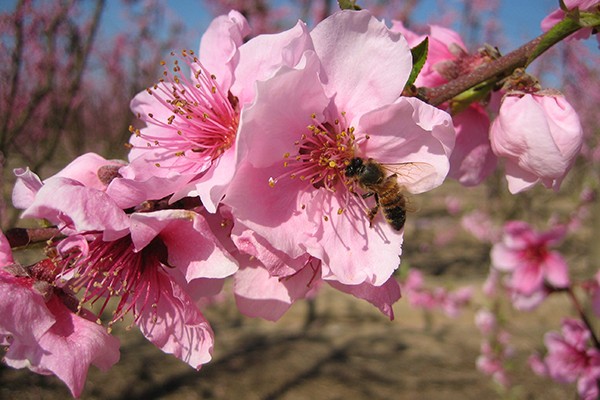This is the fourth installment of our series on sustainable farming practices, where we take a closer look at how each practice can bring long-term economic and environmental benefits.
Pests are an unfortunate reality of farming. While pesticides are a common way of dealing with them, they may not always be the best solution.
To start, they’re an additional expense. According to a recent article of the University of Illinois’ farmdoc daily, pesticides account for 19% of direct costs for Illinois corn farmers.
They’re also not the most environmentally friendly. For example, there’s evidence supporting neonicotinoids are deadly to bees, and a 2019 Science magazine article reported on a study showing the pesticides can indirectly harm beneficial insects like hoverflies and parasitic wasps.
One way to reduce the reliance on pesticides while still protecting crops and beneficial insects? Implement an integrated pest management (IPM) strategy.
What is IPM?
The USDA defines IPM as a “science-based, sustainable decision-making process that uses information on pest biology, environmental data, and technology to manage pest damage in a way that minimizes both economic costs and risks to people, property and the environment.”
The IPM Institute of North America outlines several best management practices of IPM. Those include preventive steps such as crop rotations, planting seed with pest-tolerant traits, and monitoring for potential pest problems. Control tactics can be cultural, such as turning under crop residues to destroy pest habitation, and biological, like natural predators.
A key aspect of IPM is relying on pesticides as a last resort. This should only occur when pest populations reach economic threshold levels, in which pest numbers can result in economic damage.
Significant Savings
Implementing an IPM strategy can result in several sustainable outcomes.
First is the financial aspect. By taking preventive measures, farmers can reduce the odds of crop damage and the need for pesticide application in the first place. Waiting until pests reach economic threshold levels ensures farmers aren’t spending money on pesticide applications that aren’t financially justified.
A case study completed at the University of Florida shows how effective IPM can reduce pesticide applications. On a 330-acre farm, they looked at insecticide usage under IPM on mixed vegetable crops from 2009 to 2014.
In 2011, they fully implemented the IPM program. So, from 2009-2010, the farm averaged 15.5 insecticide applications per year. But between 2011 and 2014, that dropped to 8 — a 51.6% reduction. This resulted in 40% lower insecticide costs per season.
Protecting Pollinators and Beneficial Bugs
IPM doesn’t just impact a farmer’s pocketbook. It calls for biological control, which can include encouraging the presence of predators. The University of Florida’s Institute of Food and Agricultural Sciences says less than 1% of the 100,000-plus insect species in the U.S. are harmful to plants, which means there are far greater “good” bugs that can help control the problematic ones.
Growers can support biological control by creating environments that will attract more beneficial insects to their farms. The University of California Statewide IPM Program calls these insectary plants, which provide the pollen and nectar these predators need. Growing cover crops or creating borders along fields are ways of incorporating these insectary plants into farms.
It may sound simple, but it can pay off. In Georgia, a Sustainable Agriculture Research and Education study compared cotton fields without cover crops vs. those with them to see the impact on beneficial insects. The results show:
- Aphid-consuming lady beetles seemed to move straight into cotton from the covers
- Population of predatory big-eyed bugs was higher following a crimson clover cover
- Cotton bollworm and tobacco budworm exceeded economic thresholds in both treatments but exceeded them more often in the non-cover cropped fields
These strategies also help support pollinators, which are vital to agricultural production. According to the Food and Agriculture Organization of the United Nations (FAO), three out of four crops producing fruits or seed for human food depend at least partly on pollinators, and they support the production of 87 leading food crops worldwide.
How to Get Started with IPM
You can adopt several best practices to adopt IPM on your farm, and they may not happen in consecutive order. But for a start-to-finish list, follow New York State IPM’s 7-step approach:
1. Prepare: Be aware of potential problems. Know your pests.
2. Prevent: Implement strategies that keep pests from popping up in the first place.
3. Monitor: Scout your fields and buildings. See which pests are on your crops or livestock.
4. Analyze: Consult economic threshold levels to determine when it’s time to take action.
5. Manage: Consider which tactics will reduce risk while being economically and environmentally effective.
6. Apply: When it’s time to take action, do so responsibly.
7. Reevaluate: Review the results of your actions and create proactive plans for next time.
Conterra Ag lends exclusively to American agriculture and has expertise in a variety of farm and ranch operations utilizing both traditional and sustainable farming practices. If you’re ready to refinance, or looking to grow your operation, let’s talk ag — contact your Conterra relationship manager today.

